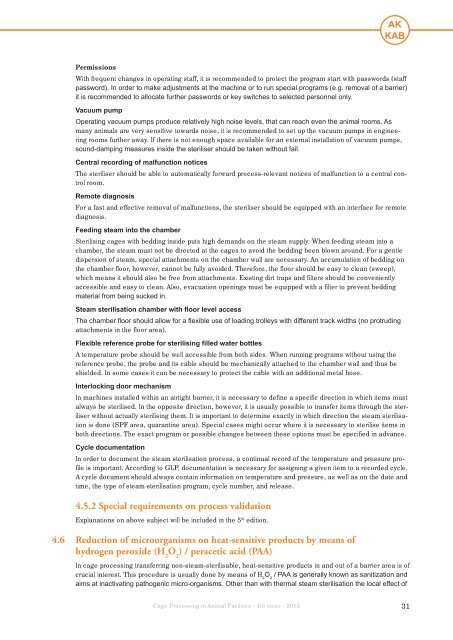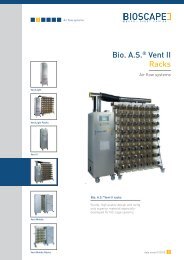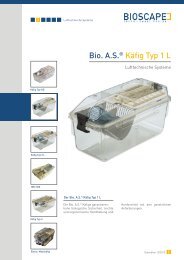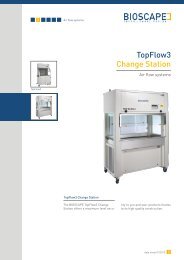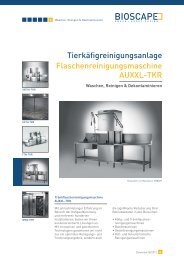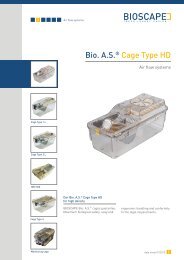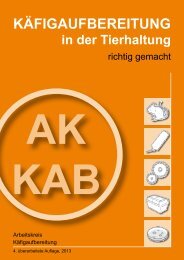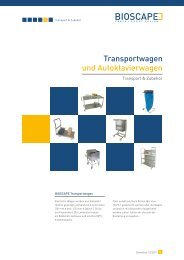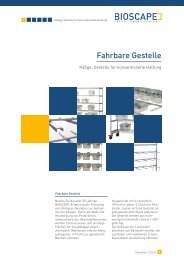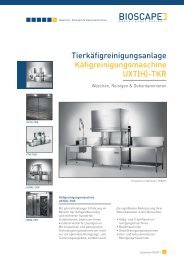CAGE PROCESSING in Animal Facilities - GV-SOLAS
CAGE PROCESSING in Animal Facilities - GV-SOLAS
CAGE PROCESSING in Animal Facilities - GV-SOLAS
Create successful ePaper yourself
Turn your PDF publications into a flip-book with our unique Google optimized e-Paper software.
PermissionsWith frequent changes <strong>in</strong> operat<strong>in</strong>g staff, it is recommended to protect the program start with passwords (staffpassword). In order to make adjustments at the mach<strong>in</strong>e or to run special programs (e.g. removal of a barrier)it is recommended to allocate further passwords or key switches to selected personnel only.Vacuum pumpOperat<strong>in</strong>g vacuum pumps produce relatively high noise levels, that can reach even the animal rooms. Asmany animals are very sensitive towards noise, it is recommended to set up the vacuum pumps <strong>in</strong> eng<strong>in</strong>eer<strong>in</strong>grooms further away. If there is not enough space available for an external <strong>in</strong>stallation of vacuum pumps,sound-damp<strong>in</strong>g measures <strong>in</strong>side the steriliser should be taken without fail.Central record<strong>in</strong>g of malfunction noticesThe steriliser should be able to automatically forward process-relevant notices of malfunction to a central controlroom.Remote diagnosisFor a fast and effective removal of malfunctions, the steriliser should be equipped with an <strong>in</strong>terface for remotediagnosis.Feed<strong>in</strong>g steam <strong>in</strong>to the chamberSterilis<strong>in</strong>g cages with bedd<strong>in</strong>g <strong>in</strong>side puts high demands on the steam supply. When feed<strong>in</strong>g steam <strong>in</strong>to achamber, the steam must not be directed at the cages to avoid the bedd<strong>in</strong>g been blown around. For a gentledispersion of steam, special attachments on the chamber wall are necessary. An accumulation of bedd<strong>in</strong>g onthe chamber floor, however, cannot be fully avoided. Therefore, the floor should be easy to clean (sweep),which means it should also be free from attachments. Exist<strong>in</strong>g dirt traps and filters should be convenientlyaccessible and easy to clean. Also, evacuation open<strong>in</strong>gs must be equipped with a filter to prevent bedd<strong>in</strong>gmaterial from be<strong>in</strong>g sucked <strong>in</strong>.Steam sterilisation chamber with floor level accessThe chamber floor should allow for a flexible use of load<strong>in</strong>g trolleys with different track widths (no protrud<strong>in</strong>gattachments <strong>in</strong> the floor area).Flexible reference probe for sterilis<strong>in</strong>g filled water bottlesA temperature probe should be well accessible from both sides. When runn<strong>in</strong>g programs without us<strong>in</strong>g thereference probe, the probe and its cable should be mechanically attached to the chamber wall and thus beshielded. In some cases it can be necessary to protect the cable with an additional metal hose.Interlock<strong>in</strong>g door mechanismIn mach<strong>in</strong>es <strong>in</strong>stalled with<strong>in</strong> an airtight barrier, it is necessary to def<strong>in</strong>e a specific direction <strong>in</strong> which items mustalways be sterilised. In the opposite direction, however, it is usually possible to transfer items through the steriliserwithout actually sterilis<strong>in</strong>g them. It is important to determ<strong>in</strong>e exactly <strong>in</strong> which direction the steam sterilisationis done (SPF area, quarant<strong>in</strong>e area). Special cases might occur where it is necessary to sterilise items <strong>in</strong>both directions. The exact program or possible changes between these options must be specified <strong>in</strong> advance.Cycle documentationIn order to document the steam sterilisation process, a cont<strong>in</strong>ual record of the temperature and pressure profileis important. Accord<strong>in</strong>g to GLP, documentation is necessary for assign<strong>in</strong>g a given item to a recorded cycle.A cycle document should always conta<strong>in</strong> <strong>in</strong>formation on temperature and pressure, as well as on the date andtime, the type of steam sterilisation program, cycle number, and release.4.5.2 Special requirements on process validationExplanations on above subject will be <strong>in</strong>cluded <strong>in</strong> the 5 th edition.4.6 Reduction of microorganisms on heat-sensitive products by means ofhydrogen peroxide (H 2O 2) / peracetic acid (PAA)In cage process<strong>in</strong>g transferr<strong>in</strong>g non-steam-sterilisable, heat-sensitive products <strong>in</strong> and out of a barrier area is ofcrucial <strong>in</strong>terest. This procedure is usually done by means of H 2O 2/ PAA is generally known as sanitization andaims at <strong>in</strong>activat<strong>in</strong>g pathogenic micro-organisms. Other than with thermal steam sterilisation the local effect ofCage Process<strong>in</strong>g <strong>in</strong> <strong>Animal</strong> <strong>Facilities</strong> · 4th issue · 2013 31


